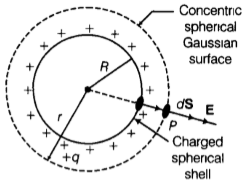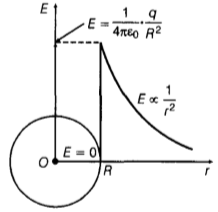Ask questions which are clear, concise and easy to understand.
Ask QuestionPosted by Parneet Kaur 6 years, 4 months ago
- 2 answers
Posted by Akanksha Guleria 6 years, 4 months ago
- 3 answers
Posted by Hitesh Sahu 6 years, 4 months ago
- 1 answers
Posted by Shubham Kumar 6 years, 4 months ago
- 2 answers
Kaustav Ghosh 6 years, 4 months ago
Yogita Ingle 6 years, 4 months ago
Potential difference is the difference in electric potential energy between two points. It is the amount of work done in moving a unit positive charge from one point to another point in an electric field. This is measured in volt.
Posted by Navneet Kumar 6 years, 4 months ago
- 2 answers
Yogita Ingle 6 years, 4 months ago
Limitations of Ohm's Law:
Ohm's law is not a fundamental law of nature. There are a number of commonly used circuit elements which do not obey this law called Non – Ohmic conductors.
Non – Ohmic conductors have one or more of the following properties:
1. Potential difference (V) depends on current (I) non-linearly.
2. The relation between V and I is non-unique, that is, for the same current I, there is more than one value of voltage V.
3. The relationship between V and I depends on the sign of V f or the same absolute value of V.
Sia ? 6 years, 4 months ago
The resistance of a material changes when the temperature changes. So when the resistance changes, the ratio of the voltage across the resistor and the current passing through it will not be a constant. We will not get the same numbers always. Non – linear elements and unilateral networks do not support ohm's law.
Posted by Sameer Khan 6 years, 4 months ago
- 1 answers
Sia ? 6 years, 4 months ago
Electric Field of Point Charge. The electric field of a point charge Q can be obtained by a straightforward application of Gauss' law. Considering a Gaussian surface in the form of a sphere at radius r, the electric field has the same magnitude at every point of the sphere and is directed outward. Let us consider charge +q be uniformly distributed over a spherical shell of radius R. Let E is to be obtained at Plying outside of spherical shell.
{tex}\because {/tex} 'E' at any point is radially outward (if charge q is positive) and has same magnitude at all points which lie at the same distance r from centre of spherical shell such that r > R.
Therefore, Gaussian surface is concentric sphere of radius r such that r > R.

By Gauss' theorem
{tex}\oint \mathbf { E } \cdot d \mathbf { S } = \frac { q } { \varepsilon _ { 0 } } \Rightarrow \oint E d S \cos 0 ^ { \circ } = \frac { q } { \varepsilon _ { 0 } }{/tex}
[{tex}\because {/tex} E and dS are along the same direction]
{tex}E \cdot \oint d S = \frac { q } { \varepsilon _ { 0 } }{/tex} [{tex}\because {/tex} Magnitude of E is same at every point on Gaussian surface]
{tex}E \times 4 \pi r ^ { 2 } = \frac { q } { \varepsilon _ { 0 } }{/tex}
{tex}\Rightarrow \quad E = \frac { 1 } { 4 \pi \varepsilon _ { 0 } } \cdot \frac { q } { r ^ { 2 } }{/tex}
Now, graph

Variation of E with r for a spherical shell in which charge q is distributed over its surface which shows that electric field inside a spherical shell is zero.
Posted by Rahul Yadav Yadav 6 years, 4 months ago
- 2 answers
Posted by Mahavir Jaat 6 years, 4 months ago
- 3 answers
Posted by Fahmida Sheikh 6 years, 4 months ago
- 1 answers
Pankaj Chadda 6 years, 4 months ago
Posted by Tanvi Bhatnagar 6 years, 4 months ago
- 3 answers
Amandeep Singh Khalsa 6 years, 4 months ago
Posted by Pratibha Mishra 6 years, 4 months ago
- 2 answers
Sia ? 6 years, 4 months ago
Posted by Thiru Nethra 6 years, 4 months ago
- 2 answers
Navneet Kumar 6 years, 4 months ago
Sia ? 6 years, 4 months ago
ii) Greater the conductivity of the electrolyte, lesser is the internal resistance of the cell. i.e. internal resistance depends on the nature of the electrolyte.
iii) The internal resistance of a cell is inversely proportional to the common area of the electrodes dipping in the electrolyte.
iv) The internal resistance of a cell depends on the nature of the electrodes.
Posted by Anil Bisht 6 years, 4 months ago
- 1 answers
Sia ? 6 years, 4 months ago
Posted by Anil Bisht 6 years, 4 months ago
- 1 answers
Sia ? 6 years, 4 months ago
Posted by Nitish Kolar 6 years, 4 months ago
- 0 answers
Posted by Preeti Chaudhary 6 years, 4 months ago
- 1 answers
Sia ? 6 years, 4 months ago
To derive Coulomb’s Law from gauss law or to find the intensity of electric field due to a point charge +q at any point in space using Gauss’s law ,draw a Gaussian sphere of radius r at the centre of which charge +q is located (Try to make the figure yourself).
All the points on this surface are equivalent and according to the symmetric consideration the electric field E has the same magnitude at every point on the surface of the sphere and it is radially outward in direction.Therefore, for a area element dS around any point P on the Gaussian surface both E and dS are directed radially outward,that is ,the angle between E and dS is zero.Therefore,
The flux passing through the area element dS ,that is,
d φ =E.dS= EdS cos 00=EdS
Hence, the total flux through the entire Gaussian sphere is obtained as,
Φ=∫EdS
Or φ=E∫dS
But ∫dS is the total surface area of the sphere and is equal to 4πr2,that is,
Φ=E(4πr2) (1)
But according to <a title="Gauss’s law for electrostatics" href="https://winnerscience.com/electromagnetic-field-theory/gauss-law-electrostatics-derivation/">Gauss’s law for electrostatics</a>
Φ=q/ε0 (2)
Where q is the charge enclosed within the closed surface
By comparing equation (1) and (2) ,we get
E(4πr2)=q/ε0
Or E=q/4πε0r2 (3)
The equation (3) is the expression for the magnitude of the intensity of electric field E at a point,distant r from the point charge +q.
In vector form, E=1/4πε0 q/r2 =1/4πε0qr/r3
In a second point charge q0be placed at the point at which the magnitude of E is computed ,then the magnitude of the force acting on the second charge q0would be
F=q0E
By substituting value of E from equation (3),we get
F=qoq/4πε0r2 (4)
The equation (4) represents the Coulomb’s Law and it is derived from gauss law.
Posted by Gourav Neemroat 6 years, 4 months ago
- 2 answers
Veerpal Kaur 6 years, 4 months ago
Pankaj Chadda 6 years, 4 months ago
Posted by Gourav Neemroat 6 years, 4 months ago
- 3 answers
Posted by Chanchal Rathore 6 years, 4 months ago
- 0 answers

myCBSEguide
Trusted by 1 Crore+ Students

Test Generator
Create papers online. It's FREE.

CUET Mock Tests
75,000+ questions to practice only on myCBSEguide app
 myCBSEguide
myCBSEguide